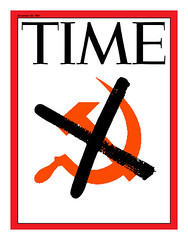X

This week Abu Musab al-Zarqawi made the cover of Time Magazine. The cover's design shows al-Zarqawi's face crossed out with an x. Time has done this kind of cover only on three other occasions. When Germany surrendered in 1945, Hitler got crossed out; later that year, when Japan surrendered, the rising sun was crossed out; and in 2003, Saddam Hussein's mug got the famous X treatment when Baghdad fell. And now Abu Musab al-Zarqawi makes the fourth time.
It's a better world to have al-Zarqawi gone. Good riddance. Time's x-treatment of al-Zarqawi makes an interesting statement about what constitutes a threat in this age. Time's first two x-covers marked the end of malevolent regimes that controlled nation states. Hitler's Germany and Tojo's Japan were corrupt governments bent on empire. Their commonality was their nationalist ideologies of racial superiority and their view that all others were to be conquered, giving them license to commit great human atrocities like Nanking and Auschwitz. They were still nation states, nonetheless. They had economies, cities, borders, populations, courts, militaries and diplomats. As evil as the German and Japanese regimes were, they had a basic commonality with the world, being a part of the Westphalian order.
Time's 1945 x-covers marked the defeat of clear threats to the international order. It's interesting to note that no x-cover came out in December, 1991 when the Soviet Union was dissolved. The lack of an x-cover to mark the end of the Cold War suggests we were reluctant to declare victory since the divide within the West deepened during that long struggle. Perhaps the West's relationship with socialism is complex, making declaring victory untenable. Maybe we just didn't want to rub it in the Russian's faces that they lost the war. The absence of a Cold War x-cover is the invisible marker that christens the era we are in now, where threats are not obvious and our determination defeat them is not unanimous.

Hilterism died in May, 1945. Japanese imperialism died in September, 1945. Soviet international communism died in December, 1991, even without a Time x-cover. Ba'athism was wounded in April, 2003 -- perhaps mortally. But Syria's Ba'athists live on, and many of Saddam's lurk in Iraq. Though Ba'athism is unlikely to revitalize, it nevertheless is not dead. And Islamicism is not dead with al-Zarqawi's demise. At best, we can celebrate the destruction of a petty thug who had tacit support from al Qaeda, a man who visited great violence on the innocent. But al-Zarqawi commanded no army that we can fully oppose. He was a part of an ideology that hates infidels and dreams of a global caliphate; but he was not in control of that ideology. Al-Zarqawi was really not in control at all -- he was an acolyte in a virtual empire, far outside of the international system. He disrupted and killed on its behalf. He waged effective asymmetrical warfare through mid-scale terror. This man is now in the rarified company of Hitler, Tojo and Saddam on the cover of Time Magazine. How far we've come.
Taken in their order of appearance, the Time x-covers illustrate how the world has changed. Relatively obscure people can quickly surface and become international threats. Medieval revivalists like al-Zarqawi are strikingly modern, in spite of their dark dreams of a restored caliphate; they're amplified by technology to the degree that they really can threaten the world order. This phenomenon will increase as technology continues to empower on the individual level. Modern technology puts control in the hands of 'the user' as much as possible. If the user is a fanatic, he might get a Time X-cover with his face on it.
There is no stopping technological innovation, nor should we attempt it. But we should recognize when it changes the rules. Whether or not Time realizes it, their four x-covers tell a story, when history moved from a top-down world to a bottom-up world. We reap many benefits from this change, but take on many risks. Al-Zarqawi is one of them.
Looking at Time's four x-covers, one can see that the threshold of what constitutes an international threat is lowering to non-state actors, even below the stature of bin Laden. Small, petty men were once made large by controlling the power of the state. Now they're made large by leveraging the power of the Internet, telecommunications, modern media and weaponizing the very things we depend on for modern life.
Time's x-covers will probably become more frequent, splashed with obscure faces whose deaths mark not the end of tyranny, but its defining moment.

<< Home